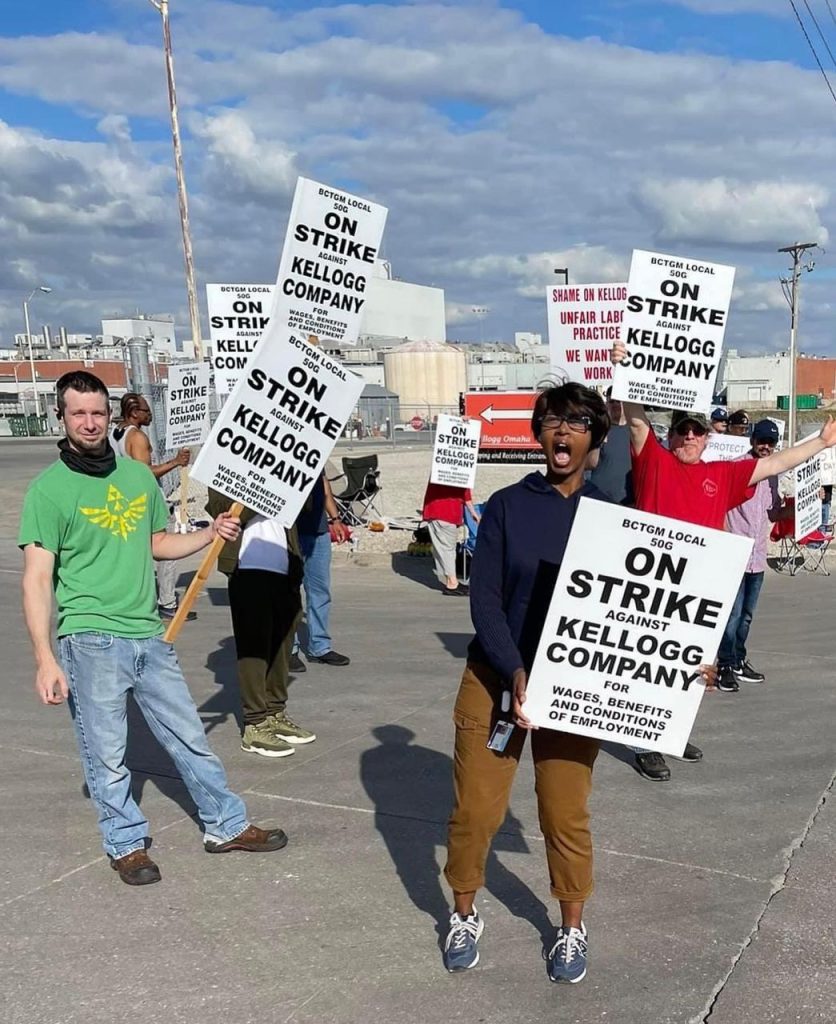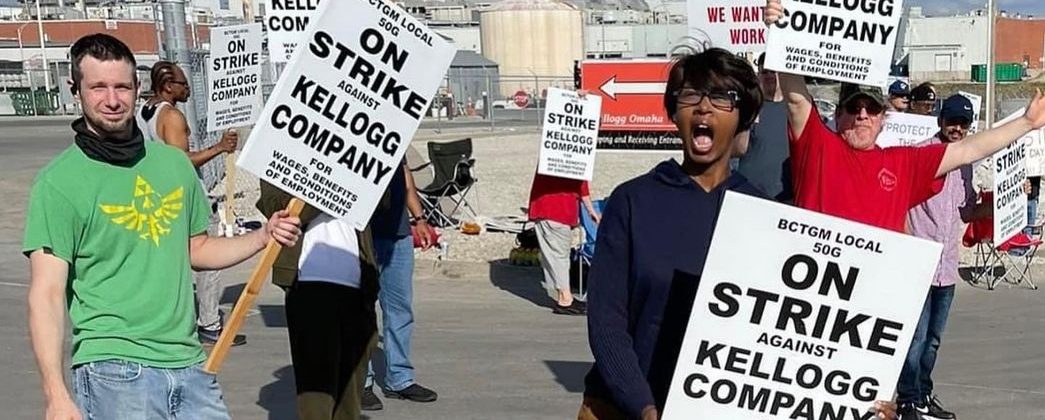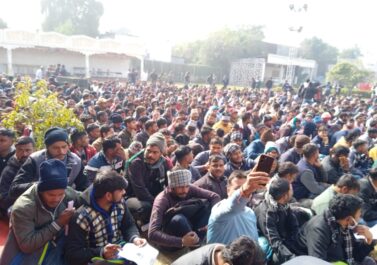
We helped translate this article from the German magazine Wildcat – a useful overview on recent developments in the USA.
‘A systemic intervention by workers’
The defeats of the working class over the last four decades have radiated from the United States. Earlier there than everywhere else, workforces were downsized and entire industries deregulated. And more than anywhere else, this led to a mix of a crisis of public infrastructure and one of togetherness – ‘everyone for themselves’. But times have changed. Almost nowhere in recent years has there been more, or broader, social protest.
Under Trump, there was a significant upswing in class struggle. In 2018/19, teachers in several states, nurses and 50,000 General Motors workers, among others, went on strike. The pandemic interrupted this upswing in labour struggles. In June 2020, however, the George Floyd Rebellion saw the largest mobilisation in the continent’s history. Many leftists and proletarians had new organising experiences. More and more black workers became politically active (we published detailed articles about this in the last three issues). Looking more closely, one could see this even before Donald Trump’s election: in the US, ‘the wind is turning’. There is now a broad discussion among leftists on the new working class, with very good contributions that clear away the … ideological obfuscations and trace concrete possibilities for struggle in the current class composition: new concentrations of workers are forming in supposedly deindustrialised regions, more and more people feel they belong ‘to’ the working class…’ (Wildcat 100, Summer 2016) [1]
Then, in 2021, there was talk of the ‘Great Resignation’ and ‘Striketober.’ In mid-October 2021, former Labour Secretary, Robert Reich, wrote in the Guardian of an ‘unofficial general strike,’ and Nobel Prize-winning economist Paul Krugman wrote in the New York Times of a, ‘revolt of the workers.’ Jacob Rosenberg commented in Mother Jones in early 2022 under the headline, ‘Workers Got Fed Up. Bosses Got Scared’, ‘that workers, in some sort of crazy-quilt general strike, did fight back.’ [2]
In the very low-paying hospital sector, workers change jobs and then usually earn more. In the ‘systemically important’ retail sector, employers are raising wages on their own initiative. Factory workers are again striking more often. And many also quit simply because they are fed up with the work…
The ‘Great Resignation’
In the pandemic, capitalism showed its ugly face to ‘essential’ workers. They kept supplies flowing, were poorly paid, and increasingly poorly treated for it. Meanwhile, the number of US billionaires grew from 614 in March 2020 to 745 in October 2021, and their accumulated wealth from $2.95 trillion to five trillion. At the same time, the US government released over a trillion dollars. Most of the money went towards propping up stock prices and corporations, but a few billion remained for an increase in unemployment benefits. In addition, the ‘eviction moratorium’ prevented tenants in breach of their lease terms from being kicked out of their apartments. Several million people who had previously worked for low wages suddenly had up to four times more income without work than they had when they were in work.
The end of the lockdown brought a few jobs. In May and June 2020 it looked like a recovery. But by July hiring was back down. It wasn’t until the Covid vaccinations kicked in, during December, that the trend reversed. In January 2021, recruitment was back above the previous month for the first time, at about 200,000, and it doubled to 400,000 by March. The vaccination campaign was off to a good start. By the end of March, a third of the US population had received at least one dose. A million new workforce recruits were expected in April.
So when the Bureau of Labor Statistics released their numbers in early May 2021, everyone was shocked: only 266,000 new hires! Anthony Klotz, a professor of management, pointed out in a Bloomberg interview that this was not due to a lack of willingness to hire on the part of business owners, but a ‘Great Resignation’ on the part of employees, should they be required to come back to the office from home working. Klotz was only thinking about the white collar workers, but Biden understood the wider dimension even then, and demanded that everyone take a job offered to them, on pain of losing their unemployment benefits. As the year progressed, it became clear that ‘Great Resignation’ described a broad social movement. A quarter of all wage earners, 46 million people, quit their jobs at least once in 2021. The Labour Force Participation Rate – the percentage of people working or looking for work – fell well below 62%. In the years leading up to the pandemic, it had consistently been above 63%, with an upward trend. 1.5% less means that more than three million people have disappeared from the labour market.
In the pandemic, workers’ behaviour changed.
Masses of people who finally had more money and free time did not return to the bad jobs. Office workers who didn’t want to catch COVID at work also quit; some retired early. In addition, there were millions of mothers who couldn’t or wouldn’t combine child-rearing with their jobs – even if they could work from home. Employees between the ages of 30 and 45 and women were the most likely to quit. Across the board, surveys indicated high levels of dissatisfaction with wages, working hours and pressure to perform. As of February 2022, there were still one and a half million fewer people employed in the hospitality industry than before the pandemic, and 400,000 fewer in the healthcare industry. At Amazon, leavers were said to have reached critical levels in the upper hierarchies. In law firms and the tech sector, many are reducing their weekly hours.
Business leaders and politicians called for a halt to unemployment benefits. In August, the ‘Eviction Moratorium’ was lifted. Then in late 2021, Elaine Chao – Secretary of Labor under Bush II, Secretary of Transportation under Trump, major shareholder in a road construction supplier and daughter of a shipping company entrepreneur – appealed to workers’ ‘patriotic duty’ to return to work. Democratic Senator, mining entrepreneur, coal lobbyist and social spending blocker Joe Manchin of West Virginia, one of the poorest US states, whined that he could not accept this ‘entitlement mentality.’
The ‘Great Resignation’ is mass individual behaviour, but in its mass nature it has great social significance. A Boston labour psychologist called it a ‘systemic intervention by workers’ and a ‘very powerful statement against the neoliberal economic policies of the last 40 years’ (interview with David Bluestein on DLF, Jan. 18, 2022). Together, workers instigated a wild year of refusal. One expression of this was the rapid growth of an online community called ‘Antiwork’ on the social website Reddit. Their slogan was: ‘Unemployment for everyone, not just the rich!’ Since the summer of 2021, the number of ‘slackers,’ as members call themselves, has grown by leaps and bounds, to nearly two million.
‘Striketober’
Concurrent with these social trends, the fall of 2021 saw an accumulation of strikes, usually referred to in the US as ‘Striketober.’ The many strikes in October were first of all a statistical phenomenon, as US-wide 450 collective bargaining agreements expired over the year, many of them in workplaces with more than 1,000 workers. But several strikes were politically important because they attacked the unequal ‘two-tier’ wage system – which showed an expression of a strengthening egalitarianism.
American Airlines had introduced this system in 1983, and business leaders had used the 2008 crisis to impose ‘two-tiers’ broadly in industry, especially the car industry – with union approval. New hires, regardless of their qualifications, are paid according to a different, significantly worse wage schedule than the old workforce. Social security benefits are also worse. In some contracts, it is possible to move up to the better category (‘top tier’) – after an agreed number of years’ service, or if a place becomes vacant because an older member of the scheme retires.
Strikes and their preconditions
As in our country, almost all collective agreements contain no-strike clauses. Only after the collective agreement expires is a strike legally permissible, and multi-year agreements are standard in the United States. Sit-down strikes, where workers stay in factories and watch out for strikebreakers, are generally prohibited .
At the heart of anti-strike legislation is the ‘Taft-Hartley’ law, introduced a year after the Great General Strike of 1946. It banned strikes in businesses defined by the government as ‘critical’, such as infrastructure and logistics. This was the beginning of the era of so-called ‘right-to-work’ laws, the prohibition of solidarity strikes, and the ability of business owners to spread anti-union propaganda in the name of free speech (‘union busting’).
The Supreme Court sides with business owners and accepts almost all of their actions against workers. Management is allowed to mandatorily send workers to propaganda events, ban non-company unionists from entering the workplace, and so on. Business owners who overstep boundaries may be admonished, but real punishments are very rare. A recent example is the dispute at BNSF, one of the largest freight railroads in the US. On Feb. 1 2022, 17,000 workers wanted to strike against a new point system for attendance that actually meant penalties for absenteeism. A federal judge had banned the strike a few days earlier, saying it concerned ‘collateral issues’ and would cause ‘substantial, immediate and irreparable harm’ to the company.
Strikes took place in 57 locations in October and there were worker protests in an additional 50 locations. A total of 100,000 workers were involved. This was preceded by a record wave of layoffs in September; more than four million workers had been sacked.
Over the course of 2021, worker protests occurred in more than 1,000 locations, a third of which were strikes. This is the highest number of strikes and the steepest increase in five years. Outside the traditionally strike-prone health and education sectors, there were over 100 strikes in mines, metal, car and food factories – the most since the 2007/08 global crisis. Manufacturing plants accounted for 35.8% of the more than three million strike days. [3] Most strikes occurred in large population centres: the East Coast, Midwest and California. But there were also large strike actions in more sparsely populated areas, for example in Huntington, a town of 50,000 in West Virginia. Here, in November – also a high point and jokingly called ‘Strikesgiving’ – 1,000 hospital workers, 50 workers at a pump manufacturer and 450 workers at a specialty alloy metal plant went on strike simultaneously.
The strike at Kellogg’s
The strike at breakfast cereal maker Kellogg’s began on October 5. 1400 strikers at four plants were directly fighting the ‘two-tier’ collective bargaining agreement. Since 2015, Kellogg’s had only hired in the lower wage scheme. In addition, workers have had to toil with 12-hour shifts during the pandemic.
Their union, the Bakery, Confectionary, Tobacco Workers and Grain Millers International Union (BCTGM), which has 70,000 members, was not eager to strike. But the three-week strike at potato chip maker Frito-Lay in July had given them confidence. There, 600 strikers had fought away the ‘suicide shift’ and forced the company to switch from a seven-day week to six. Similarly, 21,000 Nabisco workers had blocked the introduction of a ‘two-tier’ contract in a three-week strike in August and September, winning overtime pay and a $5,000 bonus. Nabisco produces cookies and snacks and is part of the Mondelez Group, which is also part of the BCTGM.
Although Kellogg’s had made record profits in the pandemic, management threatened relocation and mass layoffs, and tried to replace workers with strikebreakers. Users of the previously mentioned online community ‘Antiwork’ showed solidarity with the workers, and sabotaged the strikebreaking; they flooded the HR department with lots of fake applications. Management let trucks come in and out – until one driver told them he had nothing loaded at all; management just wanted to demoralise the strikers. The workers also didn’t see any smoke coming out of the bakery’s exhaust tower during the strikebreaking operation, so apparently they couldn’t keep the factory running. Friends sent photos showing supermarket-bought strikebreaker quality product – raw, uncooked Rice Krispies! There were two workplace accidents per week during the strike, significantly more than usual. In interviews and reports, workers strongly emphasised that they were concerned with equality (of pay, social security).
The strike ended on December 21. For now, the workers have not been able to fight away the ‘two-tier’ system. However, the lower wage tiers get three dollars more per hour, the upper only one dollar, and there are plus annual cost-of-living adjustments. Once again, the best strikebreaker was Christmas.
Strikes across all sectors
Another strike had started on October 14 at the agricultural machinery manufacturer John Deere, with 10,000 participants at 14 different locations. It ended on November 17 with wage increases of 8-10% and a six-year agreement between the company and the United Auto Workers union. Hourly wages for workers at the lowest level will rise immediately from $20 to $22. Electricians will get $33 instead of $30, plus a bonus payment of $8,500. There will be 5% wage increases in the second and fifth years, and 3% in the third, fourth and sixth years, plus cost-of-living adjustments.
A few more examples from the last few months of 2021: School bus drivers in the state of Maryland fought for a $5,000 bonus payment with a half-day strike. Several thousand workers at hospital group Kaiser Permanente threatened to strike against the implementation of a ‘two-tier’ pay schedule. Truck drivers in Colorado organised a ‘No Trucks’ protest after a scandalous court ruling against a colleague.
In early 2022, 8,000 workers at the King Soopers grocery chain went on strike for a new collective bargaining agreement and won massive improvements. In Seattle, concrete truck drivers are on strike right now (and referring to other strikes). Teacher mobilisations continue.
Tenaciously, 1,100 Warrior Met miners in Alabama are on strike. They have been trying to reverse a deterioration in conditions since April 2021, and even protested in New York in front of the headquarters of the hedge funds that own the mining company, including BlackRock. They have reached a broad public, and the mobilisation goes beyond the workers. The strike-leading United Mine Workers of America union is trying to force a settlement through the National Labor Relations Board. Some miners hired by Amazon in Bessemer are supporting the organising efforts there.
Amazon
In the spring of 2021, it looked like a union would be approved by ballot for the first time at an Amazon warehouse, at Bessemer, Alabama. However, the vote was lost. At the end of November 2021, the National Labor Relations Board upheld the union’s appeal on the grounds that Amazon had illegally influenced the election. It must be repeated by the end of March 2022. This time, 6,143 workers are eligible to vote, 350 more than a year ago. Half of the workers who participated last year no longer work there.
At the same time, workers in New York, New Jersey, and Washington DC are organising in Amazonians United, demanding a three dollar an hour wage increase, permission of cell phones in the workplace, and job protection.
At Christmas, a walkout occurred for the first time at two Amazon sites simultaneously in Chicago. Workers there had already had achieved a two-dollar-an-hour raise for January.
Wages and inflation
In January 2022, average hourly wages were 5.7% higher than the same month last year. Since the summer of 2020, the wage curve has been pointing more steeply upwards in all industries. Since then, through the third quarter of 2021, average wages are up 14% in food services, 8% in retail, 7% in health/education and manufacturing, and 6% in construction. Wages rose mostly for people in low wage jobs, and for those who changed jobs. When inflation is factored in, there were significant real wage increases. Poverty rates rose at the beginning of the pandemic but have since fallen, with supports sometimes below pre-pandemic levels. Income and wage inequality within the working class narrowed, because low wages increased more.
Inflation averaged 4.7% in 2021, rising from 1.4 to 7% in two major spurts from January to December (from February to May; then again from September), and to 7.5% in January 2022. The last time it was this high was after the years of the Volcker Shock in the early 1980s, after Central Bank Chairman Paul Volcker had massively raised interest rates in 1979 to counter the labour struggles and wage increases of the previous decades.
The current inflation rate is firstly explained by relative shortages following the 2020 lockdowns and plant shutdowns. Demand for material goods rose rapidly, as many people had more money because of government handouts, and because they saved on spending at hotels, restaurants, theme parks, and so on. The ‘Great Resignation’ exacerbated labour shortages, most notably in the transportation industry. The microchip crisis tightened the supply of cars, and corporations were able to raise prices by more than 10%. Container shipping companies and other monopolistic industries, such as energy, also took advantage of the situation to raise prices. Transportation costs contributed about 1.5 percentage points to the 4.7% inflation rate in 2021, and wage increases about one point (labour costs rose 5% in 2021). Energy prices multiplied.
US central bank the Federal Reserve (the Fed), now wants to push prices down. Conservatives argue that interest rate hikes would be necessary for this. In actuality, they are targeting wages. Interest rate hikes are supposed to force entrepreneurs to save and increase productivity; and thus, in essence, to attack workers.
‘Strikes are an appropriate weapon of the working class’
The trend that has been underway in public health and education for a couple of years has now reached industry. Workers are mobilising, and generating a force that many can relate to. Their interests are back on the agenda and finding support from colleagues, neighbours, family members, activists, journalists and others. Young people are interested in strikes. The generation that in the last 20 years had little leverage for opposing the deterioration of work, and only knew about strikes from their grandparents’ stories, is now having a completely new and positive experience. There is even a real revival of reporting on workers’ struggles, with newspaper articles and books appearing.
A 60-year-old comrade from San Francisco wrote to us in late February 2022: ‘Never before in my lifetime has ‘strike’ – and even constant use of the term ‘working class’ – become part of the everyday vocabulary of workers. Everyday, I can read about the ‘working class’ in mainstream news publications, hear it used on the radio, and even hear politicians of all ideological stripes use it. So the age of ‘class denialism’ is over. Hence the acceptance that strikes are an appropriate weapon of the working class. It’s not universal – yet – but these developments are crucial in class struggle re-occupying the center stage in working class life.’
Leftist journalist Lukas Hermsmeier, who has lived in New York since 2014 and regularly reports on mobilisations, writes in his February 2022 book ‘Uprising – America’s New Left’ that ‘capitalist realism is eroding.’ “Many people can envision an end to this system; they are already working on it. If we’re not in a new era yet, we’re at least not in the old one, where the new seemed impossible.” Disappointment with Barack Obama in particular has driven many people away from the Democratic Party and toward grassroots organisations and new protest contexts, he said.
The newest bastion of the institutional left, the Democratic Socialists of America, is more than eroding. After surging from 8,000 members in 2016 to 100,000 in 2021, a fifth of them resigned during the year. Union membership also continues to decline. As many as a third of the strikes in 2021 were by non-unionised workers. 11% took place without the union’s consent. Within unions, new grassroots pressures are emerging. ‘Striketober’ is a self-organised push from below, based on the knowledge that it is workers who keep society running. The ‘Great Resignation’ is a broad social movement challenging wage labour, and it is by no means at an end. In any case, the era of simply giving in to crushing corporate power seems to be over.
Footnotes:
[1] Among German leftists, this caused great enthusiasm over recent years. Some wanted to import the organizing and protest institutions right away: Organizing – see the seminars of the Rosa-Luxemburg-Foundation with Jane McAlevey; Jacobin; Black Lives Matter, etc.
[2] Jacob Rosenberg: Workers Got Fed Up. Bosses Got Scared. This Is How the Big Quit Happened. January+February 2022, Mother Jones.
[3] There are many articles on the question of how to count, how to compare historically, etc. Two sources may be cited here:
- Kim Moody: Upticks, Waves, and Social Upsurge, 11/15/2021, spectre journal.
- Labour Action Tracker Annual Report 2021, 2/21/2022, ILR Worker Institute.



